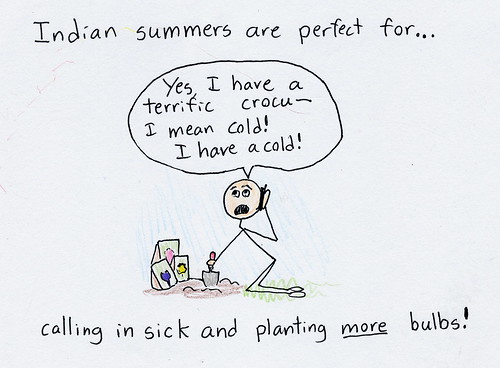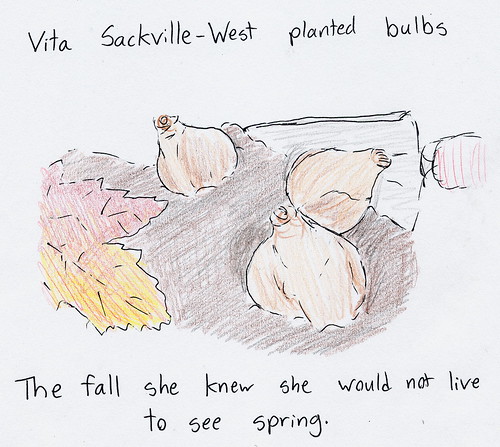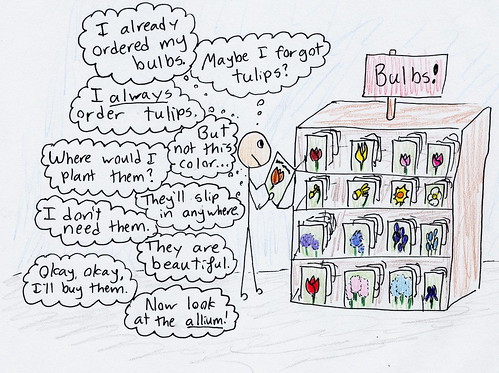I shouldn't really say the "proper" way, as there really isn't a proper way to do anything in the garden. But, after a decade of experimentation, it is by far the best method I have found for dealing with the bewitching little things. You may have other methods, but I doubt any will be quite as effective as this one.
The first critical thing is to order them from catalogs. There are practical reasons for this (price, selection, quality) but the real, essential, reason is that you can do it curled up comfortably on your couch with a hot cup of tea, gleefully circling things -- SO much more pleasant than standing in a garden center looking at bins of bulbs. It is also critically important to order your bulbs are early in the year as possible, for a reason I will explain in a moment, and this can't be done at the garden center. So order from catalogs.
To order successfully, you need to do two things: Order a lot (roughly twice as much as any reasonable person would) and order from a really great catalog.
Choosing a great catalog is a matter of taste. There are many companies with excellent selections and prices, but when curled up on the couch circling things, what really matters most is how well they are written. Every year I also get catalogs from companies whose names I can't remember with extremely low prices and garish, horrible photographs that describe each and every variety as "Amazing!" These catalogs go straight into the trash.
White Flower Farm is lovely, but over-priced and feels a bit snobbish without an extensive selection to back it up. Like a restaurant where you can't wear jeans, but the food isn't any better than the local diner. I always start to look through
Brent and Becky's Bulbs, because they have a great selection, but the prose and photography are both so poor it kills the mood, leaving me to indulge in my long-time favorite,
McClure and Zimmerman. No photos, which allows for more fun imagining things, and clear, simply worded descriptions. I read it over and over, making list after list of things I simply must have.
Once you have spent a few gleeful weeks looking over and re-looking over your order, circling this and that, imagining them all in the garden or in a vase, you finally place your order, and move on to the next critical step, which is:
Forget everything you ordered.
This is very hard to do, but very important. The first few years I gardened, I couldn't pull it off, but I've gradually become quite talented at it (I'm told it will only get easier as one gets older). I order as soon as possible and as much as possible, and once I'm done I throw myself into other gardening tasks and never, never, never look back at any bulb catalogs. As fall comes along, and you start seeing bulbs for sale at the grocery store, it is tempting to try and remember what you ordered, but resist! Keep thinking about asters and mums or your fall crop of lettuce and put bulbs out of your mind.
If you succeed, one day, you will find a big, surprisingly heavy box has arrived. You know it is full of bulbs but you don't know what bulbs they are. It is like Christmas, only better, because you needn't worry that you won't like it. You spent weeks picking them out, they are sure to be perfect, but what, oh what could they be?
My Big Box of Bulbs arrived last week and OH! It was exciting. I opened it carefully, then spent the next 10 minutes pulling out package after packaging and going "Princess Irene! OH! MORE Princess Irene! I LOVE her!" and "I can't believe I got SO MANY dwarf irises! I'm going to force a bunch of them. Oh my god! I got ANOTHER dozen of 'Harmony!'" and doing little happy dances all over the place. I didn't go quite so far as to kiss any of them, but I certainly thought about it. By the way, it is best, if possible, to do this alone. Non-gardening friends and relations who don't know that 'Princess Irene' is the most gorgeous tulip in the history of the world, a decidant orange shot with purple, won't understand the happy dances and tend to make unfortunant comments like, "How much did you SPEND on all of this?" and "Where are you going to plant them?" So, if at all possible, be alone. If not, simply ignore these comments. They are perfectly reasonable, and reasonable is the exact opposite of what you should be when dealing with bulbs.
Next, you plant them. All over the place. There is lots of good advice on planting bulbs, but it always leaves out the critical step necessary for a really successful bulb planting: Don't label them. If you MUST be organized (though I don't really advise it) you can write down what you planted where, but as soon as you do so be very sure to loose that piece of paper. Because, again, you now need to try very hard to forget everything you can. Spend the winter with seed catalogs and gardening books, thinking about tomato varieties and petunias. When spring finally arrives, you'll know there are great masses of crocuses and snowdrops and such around somewhere... but where exactly? Each warm day you can go out, carefully poking about here and there, giggling gleefully each time you find a little mass of green spikes showing through the soil. As the days warm, you'll constantly be surprised by little drifts of crocuses in full bloom. Daffodils will greet you in a corner you swear you never thought of. A thicket of tulips will errupt by the front stairs and one day reveal themselves to be 'Ballerina', the most lovely of the surpasingly elegant lily-flowered tulips, and you can sit down in delight staring at their slim, curved petals. As you are looking at them, the postman (or postwoman, as the case may be) will come by, holding a thick stack of catalogs and you can sit on the steps in the warm spring sun, and start dreaming of next year...
That is how your order bulbs. Or how you do it if you are not at all sensible. Sensible people, no doubt, do it very differently but I personally wouldn't be sensible about bulbs for anything.



